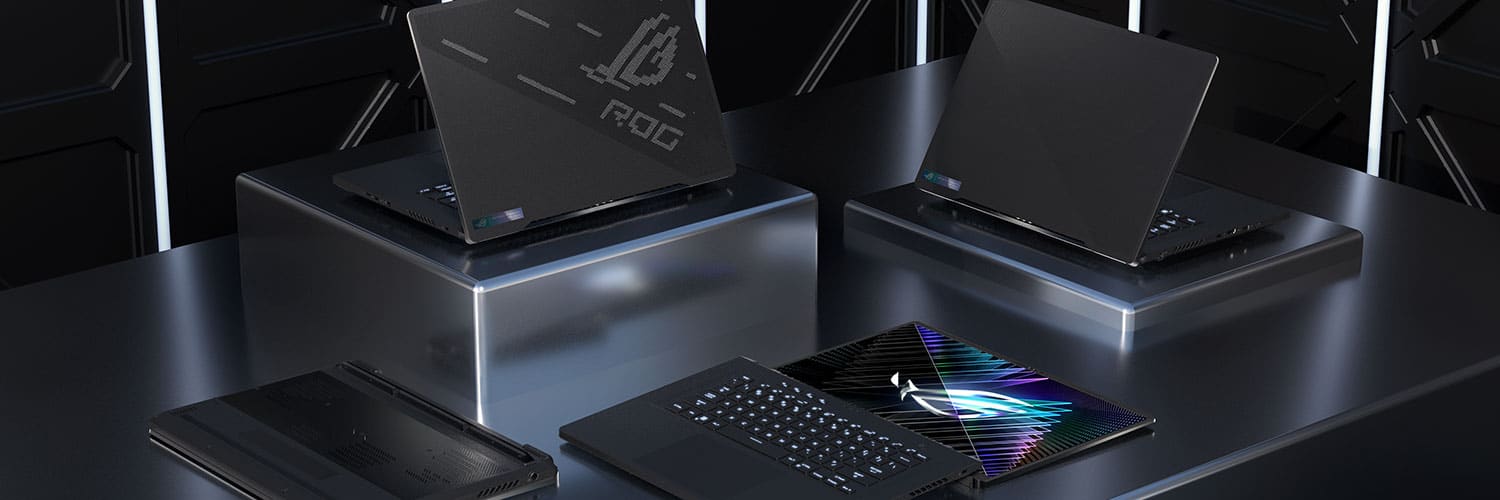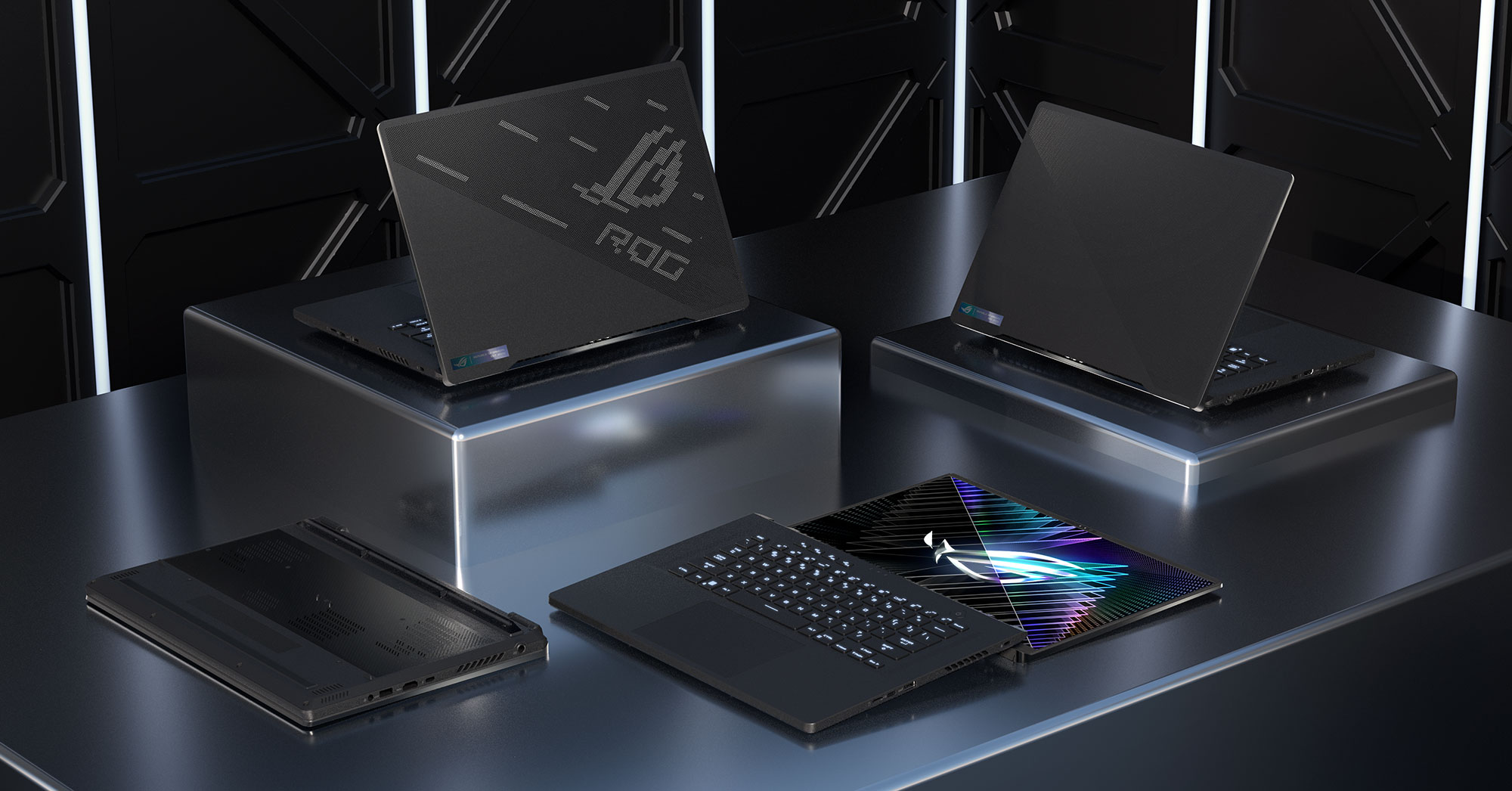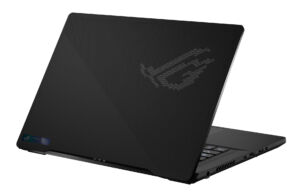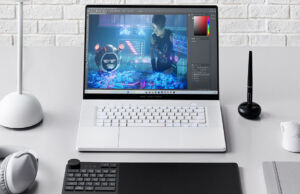Table of Contents
In this article, we’re discussing the 2023 Asus ROG Zephyrus M16 lineup of compact and lightweight performance laptops.
Asus have been offering the M16 series in stores for the last two years, but the 2023 model is a significant revamp of the previous models, although it might not seem so on a first glance.
That’s because the notable changes are on the inside, where the M16 GU604 series borrows the motherboard design and improves on the thermal module previously implemented in the ROG Flow X16 series. That allows for higher power and higher-tier specs than on the past M16 generations, as well as hopefully cooler temperatures and/or quieter fans in sustained gaming and work sessions.
The 2023 Zephyrus M16 can be configured up to an Intel Core i9-13900H processor and RTX 4090 16GB dGPU running at up to 145W of power, a notable step up from the 120W dGPUs in the past M16 and fairly close to the capabilities of the previous full-size ROG Scar laptops.
At the same time, the 2023 M16 is a little thicker and heavier than the previous models, and requires a higher-capacity charger on the top-specced models, but even so, remains a compact and portable design that you can comfortably grab along in your travels or commutes, especially if you’re willing to opt for a USB charger while on the go.
Down below we’ll go through the notable features and particularities of the 2023 Asus Zephyrus M16 series and compare it to the previous M16 model reviewed here, and we’ll follow up with an in-depth review somewhere in the next few weeks.
2023 ASUS ROG Zephyrus M16 GU604, vs. 2022 Zephyrus M16 GU603
Here’s the complete specs sheet of the 2023 Asus ROG Zephyrus M16 GU604, next to the 2022 M16 model.
| 2023 ASUS ROG Zephyrus M16 GU604 – review | 2022 ASUS ROG Zephyrus M16 GU603ZW – review | |
| Display | 16-inch, 16:10, non-touch, matte, Nebula HDR QHD+ 2560 x 1600 px, miniLED 1024 zones, 240 Hz 3ms, 1200 nits, 100% DCI-P3 QHD+ 2560 x 1600 px IPS, 165 Hz 3ms, 500 nits, DCI-P3 |
16-inch, 16:10, non-touch, matte, QHD+ 2560 x 1600 px IPS, 165 Hz 3ms, 500 nits, 100% DCI-P3 |
| Processor | Intel 13th gen Raptor Lake, up to Core i9-13900H | Intel 12th gen Alder Lake, up to Core i9-12900H, 6C+8c/20T |
| Video | Intel UHD + up to Nvidia GeForce RTX 4090 16GB (up to 145W with Dynamic Boost) with MUX, Advanced Optimus, GSync |
Intel UHD + Nvidia GeForce RTX 3070Ti Laptop 8GB (up to 120W with Dynamic Boost) with MUX and Adaptive Sync (no GSync on internal display) |
| Memory | up to 64 GB DDR5-4800 (2x DIMMs) | 32 GB DDR5-4800 (16 GB onboard, 1x DIMM, up to 48 GB) |
| Storage | 2x M.2 PCI 4.0 x4 slots | 2x M.2 PCI 4.0 x4 slots |
| Connectivity | WiFi 6E 3×3 with Bluetooth 5.2 | WiFi 6E (Intel AX211) 2×2 with Bluetooth 5.2, 2.5Gigabit LAN (Realtek RTL8125) |
| Ports | 2x USB-A 3.2 gen1, HDMI 2.1, LAN, headphone&mic, microSD card reader, Lock 1x USB-C with Thunderbolt 4 (via iGPU), 1x USB-C gen2 with data, video (via dGPU), charging |
2x USB-A 3.2 gen1, HDMI 2.0b, LAN, headphone&mic, microSD card reader, Lock 1x USB-C with Thunderbolt 4 (via iGPU), 1x USB-C gen2 with data and video (via dGPU), but no charging |
| Battery | 90Wh, 280 W power adapter + USB-C charging up to 100W | 90Wh, 240 W power adapter + USB-C charging up to 100W |
| Size | 355 mm or 13.98” (w) x 246.5 mm or 9.70″ (d) x 19.9 – 22.3 mm or .78” – 87” (h) for standard model Anime Matrix model – 21.1 – 22.9 mm or .83” – 9” (h) |
355 mm or 13.98” (w) x 243 mm or 9.57″ (d) x 19.9 – 22mm or .78” – .85” (h) |
| Weight | ~2.1 kg (4.63 lbs) for non-Anime model with IPS displazy ~2.3 kg (5.07 lbs) for Anime Matrix model with miniLED display |
2.03 kg (4.47 lbs), .71 kg (1.56 lbs) power brick and cables, EU version |
| Extras | single-zone RGB backlit keyboard, 6x speakers, FHD 2MPx IR webcam, 180 hinges, optional Anime Matrix, updated tri-fan cooling module, Off Black color | single-zone RGB backlit keyboard, 6x speakers, HD IR webcam |
Update: Here’s our detailed review of the 2023 Asus ROG Zephyrus M16 series.
Update: In the meantime, I’ve reviewed two different versions of the latest ROG Zephyrus G16 series: the Zephyrus G16 GU605MI (Core Ultra 7 + RTX 4070) and the top-specced Zephyrus G16 GU605MY (Core Ultra 9 + RTX 4090).
The overall design of the 2023 M16 hasn’t changed in any significant way from the previous chassis. The laptop is a similar boxy shape with an aluminum lid and a soft-coated main body made out of magnesium alloys.
However, some sources hint at both a black and silver variant of this M16 generation, while previously only a black model was offered. It sure looked classy and professional, but also smudged very easily and was difficult to keep clean.
That aside, Asus implemented their Anime Matrix array of dots on the lid, which they previously only offered on the Zephyrus G14 series. This is a somewhat interesting geeky feature, but one that adds up to the cost and weight, so not necessarily something I’d personally go for.
Speaking of, this 2023 ROG Zephyrus M16 is a little thicker and heavier than the previous models, at between 2.1 to 2.3 kilos between the various configurations. The heaviest variant includes fully specced internals, the Anime Matrix array, and the miniLED display option, which seems to be heavier than the standard IPS panels.
As far as these panel choices go, Asus offers a QHD+ IPS panel on most configurations, similar to the one offered on past M16s, as well as a mini LED Nebula HDR panel on the top models, with 1024 dimming zones and up to 1200-nits of peak HDR brightness. We’ve experienced the Nebula HDR panel in the ROG Flow X16, and this generation is a refined iteration, with twice de number of zones that should lead to better HDR performance and improved uniformity at lower brightness settings. The same panel is also available with the 2023 ROG Scar 16 and 2023 ROG Flow X16.
Another notable design change with this updated M16 concerns the IO, which has been slightly rearranged around the edges – there are no extra ports, though.
The PSU is now on the left edge towards the back of the laptop, so the charging cable won’t be in the way as much as on the previous model, and most of the important connectors are centrally positioned on the chassis. There are also USB-C ports on both the left and right edge now, for convenience when connecting peripherals. Both support charging, data and video.
The redesigned IO brings a slight update of the intake/output air grills as well, especially around the rear edge of the laptop, but we’ll discuss the cooling module further down.
For now, I’ll just point at that big rubber feet on the underside of the laptop, designed to facilitate proper airflow into the fans. The laptop is also an Ergolift hinge design, which means the main body lifts up on the bottom of the screen to further facilitate airflow under the main chassis. The hinges also allow for the display to lean back flat to 180 degrees, something I greatly appreciate for lap/couch use.
These aside, I’m noticing that the keyboard/touchpad haven’t changed in any significant way, so there’s no per-key RGB control on the keyboard. I’m also seeing the status LEDs still placed just under the screen, so they’re annoying when using the laptop at night. The audio system is still the same as well, with up and bottom firing speakers and solid quality for a portable laptop design – no complaints here.
Finally, the camera seems to have been updated to the newer 2MPx shooter that Asus are offering on most of their ROG notebooks this generation – it’s a little sharper and better than the past 720p shooters, but still not much.
Hardware specs and thermal design
The 2023 Asus ROG Zephyrus M16 is still an Intel+Nvidia platform and can be specced up to an Intel Core i9-13900H processor with Nvidia RTX 4090 16 GB graphics, up to 64 GB of DDR5 RAM, and 4 TB of storage.
Compared to the 2022 M16, the 2023 model offers a redesigned motherboard with two RAM slots and two M.2 2280 SSD slots.
It’s also a higher power design, as a result of implementing an updated cooling module with triple fans, a complex array of heatpipes, and a Pulsar full-length heatsink across the entire rear edge of the laptop. This allows up to 160W of crossload CPU+GPU power and up to 145W of GPU power with Dynamic Boost, a notable increase from the previous generation (140W crossload, 120W GPU).
Update: Here are the configurations available for the Asus ROG Zephyrus M16 GU604 (2023) generation:
- Asus ROG Zephyrus M16 GU604VY – Intel Core i9-13900H + RTX 4090 145W + QHD display;
- Asus ROG Zephyrus M16 GU604VZ – Intel Core i9-13900H + RTX 4080 145W + QHD display;
- Asus ROG Zephyrus M16 GU604VI – Intel Core i9-13900H + RTX 4070 140W + QHD display.
Looks like RTX 4060 and lower configurations are not available with the M16 series this year, but only with the previous chassis that’s now sold as the Asus ROG Zephyrus G16. Here’s our detailed review of this Asus ROG Zephyrus G16 lineup.
Down below is a rough image of the motherboard design and the cooling module on the 2023 Zephyrus M16 series.
This thermal module is a more advanced iteration of the cooling on the ROG Flow X16, as it gets one extra radiator and an extra heatpipe on the CPU side. The design principles are similar, though, with two main Arc Flow fans and one extra smaller fan in the middle of the chassis, meant to pull in extra fresh air over the components and onto the rear radiator. Liquid metal is applied on the CPU (not sure about the GPU) to further help out in taming these specs inside this sort of compact chassis.
Now, our past experience with the tri-fan Pulsar thermal module in the Flow X16 was more than positive, as the X16 ran cooler and quieter than the previous G15 and M16 generations. Sure, the hardware runs at higher power in this 2023 Zephyrus M16 model, so we’ll have to wait for the reviews before drawing any conclusions on this design. Our review should be available in the next few weeks.
Before we wrap this up, there are a few more things that I must add here.
First off, a larger 280W charger is required in order to cope with the power settings of this M16, but other configurations will still get the compact 240W charger used before.
Furthermore, Asus will offer this series in a multitude of variants, and while the i9 + 4090 is sure going to deliver impressive performance in this format, is also going to be very expensive. Hence, I’m rather looking forward to the mid-specced variants with maybe i9 and RTX 4070 specs, which should be the sweet spot in capabilities for money in this chassis.
Availability and pricing
The Zephyrus M16 2023 is expected in stores around the end of Q1 2023, so we should know more about the available configurations and their prices in the near future. Stay close for updates and for our reviews.
Update: Here’s our detailed review of the 2023 Asus ROG Zephyrus M16 series.
In the meantime, let me know what you think about this updated Asus ROG Zephyrus M16 GU604 generation.
I admit that to me this seems to be the most exciting Zephyrus launched so far in 2023; I don’t mind the slight increase in weight considering everything else offered here. Especially when this remains lightweight in comparison to the 2023 updates of other past thin-and-light designs, such as the Razer Blade 16 or the Alienware x16.



















Tia
February 8, 2023 at 7:29 am
I am so excited about this hm, so it'll be 2.3kg instead of the lighter 1.9kg design offered on the G16 this year. I am used to lugging an Asus ROG G551JW, which is 2.5kg by itself and 3.5kg with charger and cables, so even if it isn't super lightweight for the money, I am willing to spend top dollar for the i9 4090. Since I am coming from i7 4780H and 960M graphics, I might as well get the most top-spec model to avoid regrets about getting a lower-powered model and then finding out that the performance wasn't as expected. Though even a 4050 model of Asus ROG line will probably destroy my now nearly 9-year-old Asus ROG G551JW in performance vs the 960M GPU but might as well get the best and enjoy that mini led screen with 1100 nits brightness 1600p 16:10 16" screen and the 240Hz refresh rate which matches the monitor I am typing to you on although only 1080p. So yeah, I guess I do miss the ethernet port wish they had put that in instead of the G16 and made a full-sized SD card reader so that creatives could use it too oh well, wifi 7 is the future, and I am hoping to spend at least $7000 aud on this machine and use it for the next 10 years.
Tia
February 8, 2023 at 7:37 am
Oh, how could I forget the double ram slots up to 64GB and Nvidia's Advanced Optimus technology are the icing on top! As well as the new colour way, though, I had hoped we would get an all-white version of the M16 for years. Still, I am excited to see these models come out at the end of March or early April and see yours and other reviewers written and in video format on YouTube on this M16 model. I hope my Asus ROG G551JW can survive till then, as it has been having issues, such as the original charger dying. Luckily I have a spare and check disk running at start-up on the C Drive.